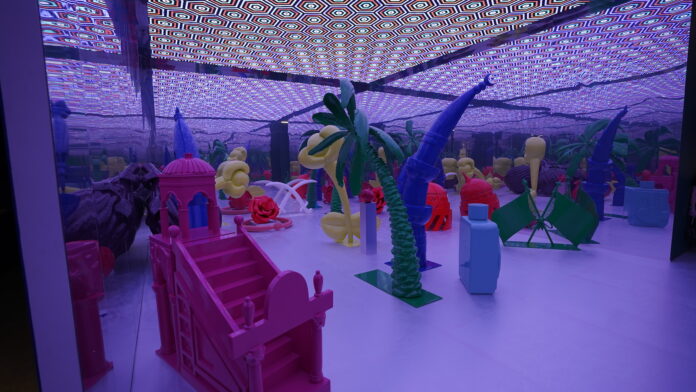‘The Holy Land’
Sultan bin Fahad
Much of Saudi artist Sultan bin Fahad’s work involves the use of found objects or souvenirs and in this mixed-media installation, commissioned for the biennale, he “celebrates the souvenirs and other wares that were once sold by merchants to pilgrims in the two holy cities of Makkah and Madinah,” according to a statement on Instagram. “These thermos flasks, prayer mats, bottles, and tins, all decorated in the style of their countries of origin, represent vestiges of an economy now extinct.” The artist has used images found on these flasks to create “a garden of love and joy,” through which visitors can pick their own path.
‘Amongst Men’
Haroon Gunn-Salie
The South African artist’s installation was first presented in 2014 and has been growing ever since (this iteration at the Islamic Arts Biennale contains 600 more of its suspended kufia casts than the original work). It is a recreation of the funeral of South African Muslim cleric and anti-apartheid activist Imam Abdullah Haron, which was reportedly attended by 40,000 mourners. The mourners are represented by the suspended casts, inviting viewers to join in with the remembrance of Haron, who died in police custody in 1969. A government inquest into his death ruled that his two broken ribs and 27 bruises had been caused by falling down some stairs. This is one of several works that Gunn-Salie has created in memory of Haron.
‘Maintaining the Sacred’
Dima Srouji
The Palestinian architect and artist’s installation is a reminder of the incursion of Israeli forces into the Haram Al-Sharif (Temple Mount) in Jerusalem in April last year. The soldiers smashed 30 of the colored-glass windows that adorn the Dome of the Rock and Al-Aqsa Mosque, damage that would reportedly take around 15 years’ worth of work to repair (each window is made of hand-carved plaster with inset colored glass pieces, and takes around six months to remake) even if the Israeli authorities hadn’t blocked their reconstruction. “The technique is a dying craft with a few practitioners in Yemen, one in Cairo, and another in Jerusalem,” the artist’s statement says. The work was created “in honor of the history of craft, the worshippers seeking a connection with the spiritual world despite the fragility of the space, and of the bodies protecting our public space.”
‘Letters in Light, Lines We Write’
Muhannad Shono
The self-taught Saudi multidisciplinary artist’s work often focuses on the contrast between light and darkness — teasing out themes of good versus evil, spirituality and belonging. Last year, hetold an audience in London that he is drawn to creating work that “disrupts everyday living” in order to shift the viewer’s mindset, and this large-scale work, which uses thread, steel and light projection, is both soothing and thought-provoking.
‘The River Remembers’
Kamruzzaman Shadhin The Bangladeshi artist’s installation for the biennale is inspired by stories told to him when he was a child — particularly his mother’s stories of her grandparents’ house on the Teesta river which they lost when the 1947 partition forced them to relocate to Bangladesh and his neighbor Johura Begum’s tale of her own journey across the new border via the Brahmaputra river. “Such stories shaped the artist’s imagination and with them he inherited a strange longing for places where he had never lived,” according to a statement. The piece’s multiple veils are woven using a traditional technique called shika — a craft practiced by Begum. “Using the powerful imagery of rivers to suggest the unseen forces that can direct the course of our lives, this very personal work speaks eloquently of migration, ecology, and, most of all, of dislocation and homecoming,” the statement reads.

